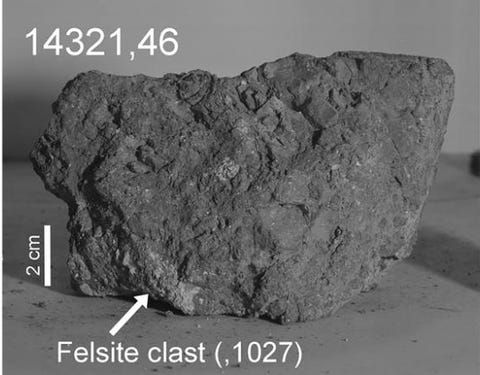Earth's Oldest Known Rock Was Found on the Moon
One of the moon rocks collected by Apollo 14 actually originated on the Earth.
By Avery Thompson
GETTY IMAGES/NASA NASA
A lot of the rocks we have on Earth are pretty old, but none of them were around when our planet was first formed. The Earth itself is around 4.5 billion years old, and the oldest rocks we’ve ever found are a little over half that age. That seems to have changed, however, because a group of scientists recently announced they’ve found a rock that formed only half a billion years after the Earth itself. The twist is that this particular rock wasn’t discovered on Earth at all. It was found on the moon.
The rock itself was discovered decades ago by the Apollo 14 crew. The Apollo missions brought back a whole lot of rock samples, and scientists have been methodically analyzing them ever since. This one seems to have been somewhere near the end of the list, but it may be the most interesting one ever found.
According to the analysis, this rock formed somewhere between 4 and 4.1 billion years ago, about 12.4 miles beneath the Earth’s crust. Researchers knew it came from the Earth based on the amount of various minerals like quartz and feldspar, which are common on Earth but rare on the Moon. They could tell how deep it was based on a molecular analysis of the rock, which can tell the researchers what temperature the rock was at when it formed.

An image of the Earth rock found by the Apollo 14 crew.
DAVID A. KRING/CENTER FOR LUNAR SCIENCE AND EXPLORATION
Technically, it’s possible that this rock could have formed on the moon, but it would have been one heck of a coincidence. The rock would have to be made of an extremely high amount of earth minerals and an extremely low amount of minerals common on the moon, something not found in any other moon rock samples. And it would have to have formed in the moon’s core, then somehow make it to the surface.
But is it any less of a coincidence that an Earth rock could have ended up on the moon? Actually, yes. After all, the moon itself was once a piece of Earth, until it was forcefully ejected into orbit by a collision with a particularly large asteroid early in our planet’s history. We’ve even found pieces of Mars falling to the ground here on Earth after they were kicked into space by an impact. It’s not hard to imagine, in the early years of our Solar System when large asteroids were everywhere, that one of them hit the Earth and sent debris flying into space. At least some of that debris could have easily ended up on the Moon.
Before this discovery, we had to guess at what the rocks of the early Earth looked like, but now we have a much better idea. And there’s a good chance that this isn’t the only Earth rock sitting on our lunar neighbor. We may even have more earth rocks collected from other Apollo missions.
If we ever go back to the moon again, we might find more Earth samples lying around the surface. Returning to the moon is almost worth it for that reason alone.
No comments:
Post a Comment